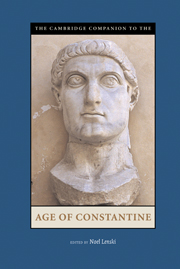Book contents
- Frontmatter
- Introduction
- 1 Sources for the History of Constantine
- Section 1 Politics and Personalities
- Section II Religion and Spiritual Life
- Section III Law and Society
- Section IV Art and Culture
- 11 Perspectives in Art
- 12 Architecture of Empire
- 13 Constantine in Legendary Literature
- Section V Empire and Beyond
- Appendix 1: Stemmata
- Appendix 2: Timeline
- Maps
- Primary Sources and Translations
- Secondary Bibliography
- Index
11 - Perspectives in Art
from Section IV - Art and Culture
Published online by Cambridge University Press: 28 September 2007
- Frontmatter
- Introduction
- 1 Sources for the History of Constantine
- Section 1 Politics and Personalities
- Section II Religion and Spiritual Life
- Section III Law and Society
- Section IV Art and Culture
- 11 Perspectives in Art
- 12 Architecture of Empire
- 13 Constantine in Legendary Literature
- Section V Empire and Beyond
- Appendix 1: Stemmata
- Appendix 2: Timeline
- Maps
- Primary Sources and Translations
- Secondary Bibliography
- Index
Summary
Introduction: Perspectives and Problems
Constantine ruled longer than any other Roman emperor after Augustus. The changes inaugurated in his Principate were arguably still greater and longer lasting for European history even than those instigated by his illustrious predecessor. In the visual arts, my subject here, developments under Constantine can be seen from more than one perspective. In one sense they represent a moment of major transformation in the history of art: the state began actively to sponsor the architecture and imagery of Christianity and thus to put the force of the establishment behind changes in image-making that would culminate in the move from pagan to Christian art and the (not wholly unrelated) move from the practices and aesthetics of Graeco-Roman art to those of the early Middle Ages. This latter is a long process, beginning well before Constantine’s reign (scholars have sought its inception as early as the Flavian period and at numerous occasions thereafter) and ending perhaps as late as the sixth century. It is a process which some have attributed to the internal dynamics within Roman image-making and others to the influence of external traditions of art, especially from the Near East. From a narrower perspective, the images produced in Constantine’s reign allowed for significant innovations within the dynamics of imperial propagation of Roman state art. Whether these innovations constituted a “revolution” of the kind associated with Augustan image-making is perhaps a moot point - very difficult to assess because of the relatively poor state of the empirical evidence.
- Type
- Chapter
- Information
- The Cambridge Companion to the Age of Constantine , pp. 255 - 277Publisher: Cambridge University PressPrint publication year: 2005
- 2
- Cited by

